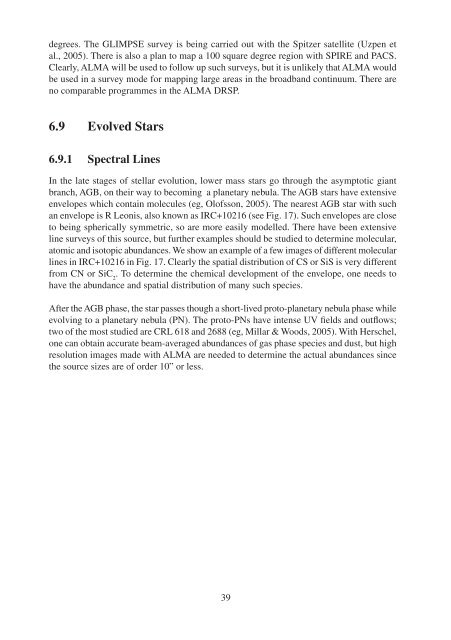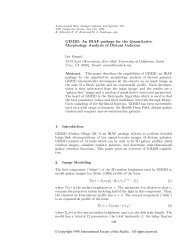4 Comparison of the ALMA and Herschel - ESO
4 Comparison of the ALMA and Herschel - ESO
4 Comparison of the ALMA and Herschel - ESO
Create successful ePaper yourself
Turn your PDF publications into a flip-book with our unique Google optimized e-Paper software.
degrees. The GLIMPSE survey is being carried out with <strong>the</strong> Spitzer satellite (Uzpen et<br />
al., 2005). There is also a plan to map a 100 square degree region with SPIRE <strong>and</strong> PACS.<br />
Clearly, <strong>ALMA</strong> will be used to follow up such surveys, but it is unlikely that <strong>ALMA</strong> would<br />
be used in a survey mode for mapping large areas in <strong>the</strong> broadb<strong>and</strong> continuum. There are<br />
no comparable programmes in <strong>the</strong> <strong>ALMA</strong> DRSP.<br />
6.9 Evolved Stars<br />
6.9.1 Spectral Lines<br />
In <strong>the</strong> late stages <strong>of</strong> stellar evolution, lower mass stars go through <strong>the</strong> asymptotic giant<br />
branch, AGB, on <strong>the</strong>ir way to becoming a planetary nebula. The AGB stars have extensive<br />
envelopes which contain molecules (eg, Ol<strong>of</strong>sson, 2005). The nearest AGB star with such<br />
an envelope is R Leonis, also known as IRC+10216 (see Fig. 17). Such envelopes are close<br />
to being spherically symmetric, so are more easily modelled. There have been extensive<br />
line surveys <strong>of</strong> this source, but fur<strong>the</strong>r examples should be studied to determine molecular,<br />
atomic <strong>and</strong> isotopic abundances. We show an example <strong>of</strong> a few images <strong>of</strong> different molecular<br />
lines in IRC+10216 in Fig. 17. Clearly <strong>the</strong> spatial distribution <strong>of</strong> CS or SiS is very different<br />
from CN or SiC 2<br />
. To determine <strong>the</strong> chemical development <strong>of</strong> <strong>the</strong> envelope, one needs to<br />
have <strong>the</strong> abundance <strong>and</strong> spatial distribution <strong>of</strong> many such species.<br />
After <strong>the</strong> AGB phase, <strong>the</strong> star passes though a short-lived proto-planetary nebula phase while<br />
evolving to a planetary nebula (PN). The proto-PNs have intense UV fields <strong>and</strong> outflows;<br />
two <strong>of</strong> <strong>the</strong> most studied are CRL 618 <strong>and</strong> 2688 (eg, Millar & Woods, 2005). With <strong>Herschel</strong>,<br />
one can obtain accurate beam-averaged abundances <strong>of</strong> gas phase species <strong>and</strong> dust, but high<br />
resolution images made with <strong>ALMA</strong> are needed to determine <strong>the</strong> actual abundances since<br />
<strong>the</strong> source sizes are <strong>of</strong> order 10” or less.<br />
39




